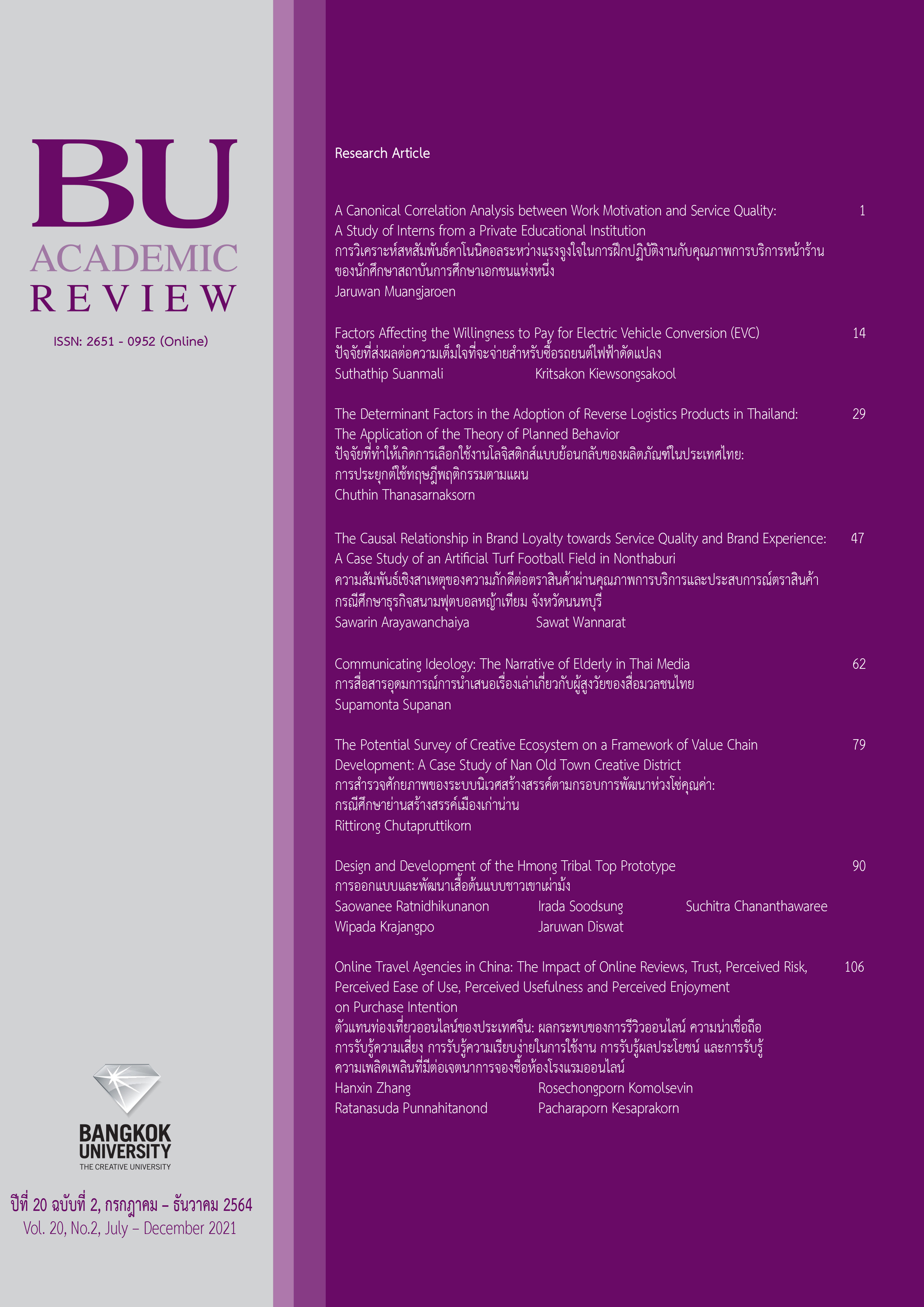การออกแบบและพัฒนาเสื้อต้นแบบชาวเขาเผ่าม้ง
Main Article Content
บทคัดย่อ
งานวิจัยนี้มีวัตถุประสงค์ดังต่อไปนี้คือ 1) เพื่อศึกษารูปแบบและวิธีการทำแบบตัดเสื้อต้นแบบชาวเขาเผ่าม้ง 2) เพื่อออกแบบและพัฒนาเสื้อต้นแบบชาวเขาเผ่าม้ง และ 3) เพื่อศึกษาความพึงพอใจที่มีต่อเสื้อต้นแบบชาวเขาเผ่าม้ง กลุ่มตัวอย่างที่ใช้ในการวิจัย คือ กลุ่มชาวเขาเผ่าม้ง จำนวน 378 คนที่อาศัยอยู่ในเขตอำเภอแม่แจ่ม อำเภอ สะเมิง อำเภอกัลยาณิวัฒนา จังหวัดเชียงใหม่โดยเลือกมาแบบบังเอิญ เครื่องมือที่ใช้ในการเก็บข้อมูล คือ แบบสอบถามความพึงพอใจที่มีต่อการออกแบบและพัฒนาเสื้อต้นแบบชาวเขาเผ่าม้ง ด้านรูปแบบ ด้านการตัดเย็บ ด้านการสวมใส่ ด้านแบบตัด และผลงานวิจัยประกอบด้วย เสื้อต้นแบบชาวเขาเผ่าม้ง บุรุษ 2 แบบ และสตรี 2 แบบ การวิเคราะห์ข้อมูลใช้สถิติร้อยละ ค่าความถี่ ค่าเฉลี่ย และส่วนเบี่ยงเบนมาตรฐาน ผลการวิจัยพบว่า ชาวเขาเผ่าม้งไม่มีการสร้างแบบตัดเสื้อแต่ใช้วิธีการคาดคะเน แบบเสื้อชาวเขาเผ่าม้งที่ได้รับคะแนนสูงสุดเพื่อมาเป็นเสื้อต้นแบบนั้นจะเป็นแบบที่สวมใส่สบาย เคลื่อนไหวสะดวก และไม่รัดรูป ผลการศึกษาความพึงพอใจของกลุ่มตัวอย่างพบว่า กลุ่มตัวอย่างชายมีความพึงพอใจต่อเสื้อต้นแบบบุรุษแบบที่ 1 (ค่าเฉลี่ย=4.31, SD=0.37) สูงกว่าแบบที่ 2 (ค่าเฉลี่ย=4.25, SD=0.35) อย่างมีนัยสำคัญทางสถิติที่ระดับ 0.05 โดยมีความพึงพอใจภาพรวมอยู่ในระดับมาก และกลุ่มตัวอย่างหญิงมีความพึงพอใจต่อเสื้อต้นแบบสตรีแบบที่ 1 (ค่าเฉลี่ย=4.35, SD=0.49) สูงกว่าแบบที่ 2 (ค่าเฉลี่ย=4.27, SD=0.42) อย่างมีนัยสำคัญทางสถิติที่ระดับ 0.05 โดยความพึงพอใจภาพรวมอยู่ในระดับมาก
Article Details
บทความที่นำมาสมัครลงตีพิมพ์ในวารสารต้องไม่เคยได้รับการตีพิมพ์เผยแพร่มาก่อน และไม่ส่งต้นฉบับบทความซ้ำซ้อนกับวารสารอื่น รวมทั้งผู้เขียนบทความต้องไม่ละเมิดหรือคัดลอกผลงานของผู้อื่น
เอกสารอ้างอิง
Best, J., & Kahn, J. (1998). Research in education (8th ed.). London: Pearson.
DeVellis, R. F. (1991). Scale development: Theory and applications (4th ed.). New York: Sage
Publications.
Kraisuwan, S., Piromthamsiri, K., & Wongtong, O. (2010). Sư̄aphā chon phao Thai: Rūpbǣp læ theknik kān tat yep sư̄aphā chāo khao phao mong namngœ̄n krarīang yao læ mūsœ̄ dam
[Thai ethnic's clothing: Style and construction technique of blue Hmong, Karen, Yao and
Black Lahu Tribals]. Kasetsart Journal of Social Sciences, 31(2), 194-205.
Leepreecha, P. (2011). Klum chāttiphan mong nai bō̜ribot khō̜ng rat chāt samai mai nai mong
Lāo nai prathēt Thai [Hmong ethnic groups in the context of a modern nation-state in the
Hmong in Thailand]. Bangkok: Arun Press.
Nuannoi, B. (1999). Lakkān ʻō̜k bǣp [The design concept]. Bangkok: Chulalongkorn University.
Phuaksri, J. (2003). Kānʻō̜kbǣp sư̄a nưng [Principles of design 1]. Bangkok: Academic Support
Center.
Rodkum, J., Egwutvongsa, S., & Saributr, U. (2012). Kānsưksā ʻēkkalak chāo khao phaomong
ʻamphœ̄ phop phra čhangwat Tāk phư̄a kānʻō̜kbǣp khrư̄angpradap [Study Hmong tribe
identity of Phop Phra Tak province for jewelry design]. Art and Architecture Journal
Naresuan University, 7(1), 132-145.
Sonprom, S., Saributr, U., & Sodpibarn, P. (2016). Kānsưksā læ ʻō̜k bǣp phalittaphan čhāk phā pak
ʻattalak chāttiphan mong [The study and product from Hong identity embroidery]. Art and
Architecture journal Naresuan University, 7(2), 110-123.
Siracha, S. (2017). Kānphatthanā bǣp tat tonbǣp sư̄aphā sattrī ʻāyu hāsip pī khưn pai tām laksana
rūprāng sattrī Thai [The development of a master pattern for women’s wear based on the
aged over 50 Thai shape]. Art Pritas Journal Faculty of Fine and Applied Arts, Suansunandha
Rajabhat University, 2, 100-106.
Sisaat, B. (1992). Lakkān wičhai bư̄angton [Introduction to research methodology (3rd ed.)].
Bangkok: Suwiriyasan.
Sonprint, W. (2008). Kānphatthanā kānʻō̜kbǣp bǣp tat dōi kānchai sēn bon sư̄aphā hai mo̜som
kap sattrī thī mī rūprāng ʻūan [Pattern design development by using lines for overweight ladies] (Master’s thesis, Rajamangala University of Technology Phra Nakhon).
Teerachai, S. (2001). Kānʻō̜kbǣp phalittaphan ʻutsāhakam [Industrial product design]. Bangkok:
Odian Store Press.
The Support Arts and Crafts International Centre of Thailand. (2014). Yep pak thak thō̜ ʻēkkalak
læ sinlapa lūatlāi phā chāo khao [Sewing, embroidery, knitting and weaving identity and art
of hill tribe fabric patterns]. Bangkok: Siam color print.
Yamane, T. (1973). Statistics: An introductory analysis (3rd ed.). New York: Harper and Row.


